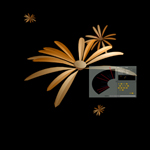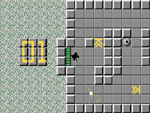RESEARCH |
| |
EXPLORING AN ORGANIC matt grenby, john maeda |
In your mind's eye,
consider an ancient oak tree, solitary on the crest of a hill in an open
field. From a distance you can appreciate the over-all form of the tree:
the strange symmetries of the branch network, the shape and color of the
canopy. As you come nearer, you notice the leaves rustling in the breeze.
Strong winds have torn certain branches away from the trunk. You see faint
traces of charred bark, indicating that at one point this tree survived
a fire in the field. The tree is teeming with life, from the birds which
temporarily alight on a branch to rest, to the ants and grubs which make
a meal of leaves. We know a significant amount about this particular tree.
No text. No numbers. All this information has been gleaned from a quick
examination of only the formal qualities of an object: its shape, not its
numbers. Now consider the stock pages of the Wall Street Journal. Columns and columns of miniscule sans-serif type, accurately detailing the smallest fluctuation in price, volume and thereby intrinsic value of any particular security you care to track. Step back from the page. Observe the larger structures: line-spacing, margins, column width, the dimensions of the pages. These pages are the picture of refinement: carefully managed, rational, terminally specialized. Unlike the tree, separate representations are required to meaningfully express the micro and the macro. The listings are the micro view of a particular exchange; separate graphs and charts are used to communicate the macro: trends in the over-all market, the state of national economies. In our research, we strive to create representations of information that incorporate the qualities of natural expectation and familiarity usually found in organic systems with the efficacy and focus of traditional alphanumeric descriptions. Gradus, a conceptual visualization of the English language was, the first step in this direction. Headwords from the dictionary were plotted along three axes (time, alphabetic, frequency) and then packed along their vector to the origin. The resulting, tornado-like form reveals features of the history of English. For instance, a bulge halfway up the structure represents the burgeoning of words entering the language around the time of the Renaissance. In this case, rational categorization coupled with a shape-based representation serve to give an understanding of the underlying body of information which traditional structures, such as books, could never afford. Our most recent research expands on the ideas presented in gradus, with an emphasis on increasing the sophistication of the atomic unit of the system. Whereas gradus was based on an individual word, gloms (information agglomerations) use data blooms to embody an individual dataset. A companion, Internet-based game is used as the source of information for the glom system while data blooms (fig. 1) display all information relevant to an individual player's history. The line between verbatim duplication of natural objects and the creation of new, computational structures which leverage off the expectations of the natural is a thin one. We are less interested in creating a virtual flower than we are in understanding what it is about a flower that allows us to so quickly come to an assesment of its state. These are the qualities we strive to abstract and incorporate within our visualizations. In this way we move towards the realization of a meaningful organic architecture. |
[MATT
GRENBY] [BLITZ] [GRADUS] |


